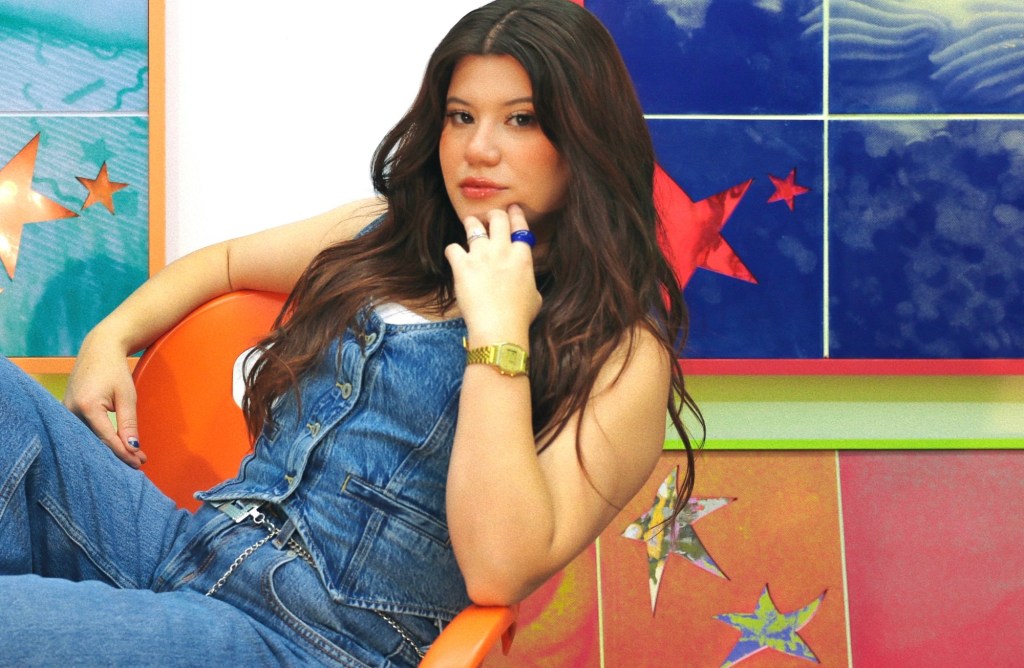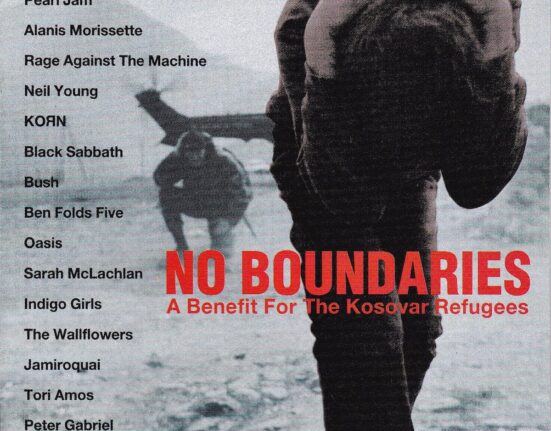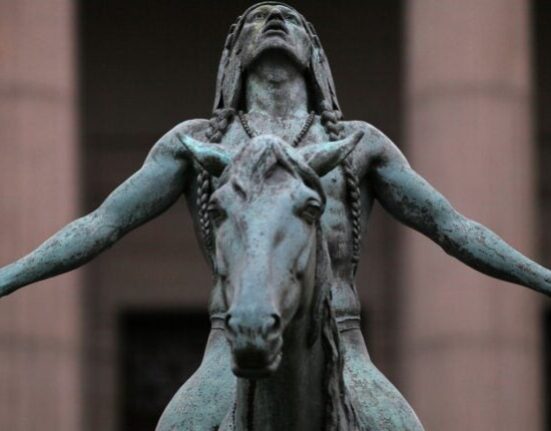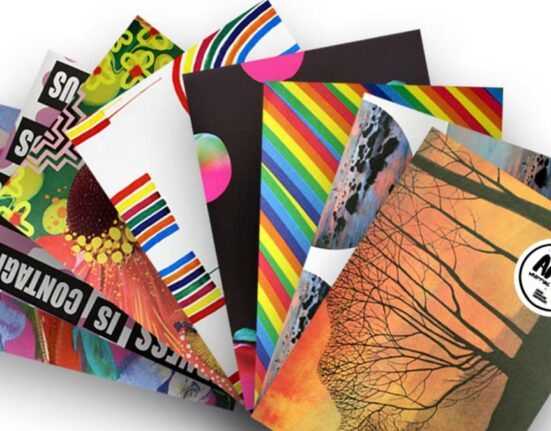Deanna Barahona appreciates a good Chuck E. Cheese.
In her recent thesis exhibition at UC San Diego, she showcased a piece called “They Still Have Animatronics at the Northridge Location.” The title of the piece is fairly unambiguous, a reference to the robotic music bands that were once a staple at the pizza chain, but have since been phased out.
The piece itself is much more layered, both aesthetically and metaphorically. Using inkjet-printed imagery on ceramic tile — and peppered with paint, wood and glitter — Barahona is using a family party photo at a Chuck E. Cheese to explore how the chain itself “reflects more significant societal shifts, including White flight,” as she puts it.
Aesthetic choices in the piece help to drive home these points: the two purple Tweety Bird characters, the crass glittering stars and the text in both English and Spanish. Still, there’s something immediately accessible about the art with the family photo and vibrant colors invoking warm feelings and nostalgic recollections in the viewer.
“I don’t know, I’d like to think that I lead with cool and pretty,” Barahona said, laughing. “The look is important and I don’t want to pretend that it’s not. I like things that are cool and pretty, but I also like to think it’s layered and that it comes together nicely.”
Barahona’s work is decidedly “cool” and “pretty,” but she’s correct in that it’s multilayered, multifaceted and multidisciplinary.

In that UCSD exhibition, “All I Can Leave You is the Glitter,” she displayed a number of large-scale, screenprint-and-tile pieces that gave a more micro view into family and culture. Using her own family history and photos as initial templates, often zoomed and pixelated, her work aims to explore, as she puts it, “the impression of memories and ephemerality” specifically those in the Latin American community.
By taking a more narrowed focus, Barahona isn’t simply mining her own family’s history for inspiration or source material. Rather, she’s attempting to examine, however personally, the items and ephemera that make up these lives, a more focused assessment and appreciation for the people and objects that are often out of focus.
“Working with my family history, I’m trying to figure out what it is that I’m going to pull apart from what my parents have and what I have,” Barahona said. “What is lost and what is in between.”
“What is important to me is what is being left out,” she continued. “As we continue to move forward into the digital age, we don’t really get that anymore. We’re too focused on taking these perfect photos, or what we think are the perfect photos, and we discard the rest. We discard the blurry photos, we discard the people who are doing things in the background that we don’t like. We keep the nice photo and get rid of the rest, and I don’t like that.”
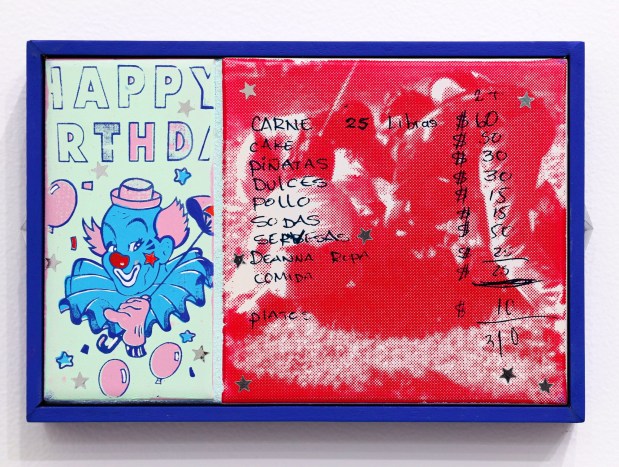
Pieces such as “Save Me Candy!” and “El Future” also use family photos, with a focus on these peripheral elements while incorporating street art-style imagery and text. By combining fine art methodologies and executions — along with elements that, in the past, would be considered too lowbrow for a gallery show or the like — she offers up an outlook that is both unique and thematically universal.
Put simply, what makes Barahona’s work so special is not only her use of familial characters and nostalgic photo treatments, but the way in which she presents them as something that seems already relatable to the viewer.
“It’s interesting to me — that I’ve seen these photos a million times since I was a kid, but I’m always finding something else within the photograph that I love that I didn’t notice before,” said Barahona, who used family photos she’s held onto over the years. “I feel like that method has helped me in my practice, paying attention not to the subject, but to the background, what’s on the table, how they decorated the house and what they were wearing at the time.”
A first-generation daughter of Central American parents, Barahona grew up primarily in Bakersfield. She acknowledges that her parents nourished her artistic inclinations, but that she never considered a career in art when she was younger.
“I was always the artistic kid growing up. I think my parents were nice about it and really nourished it even though that’s probably not what they imagined me doing in the future,” Barahona recalled. “But there was always that want to do it.”
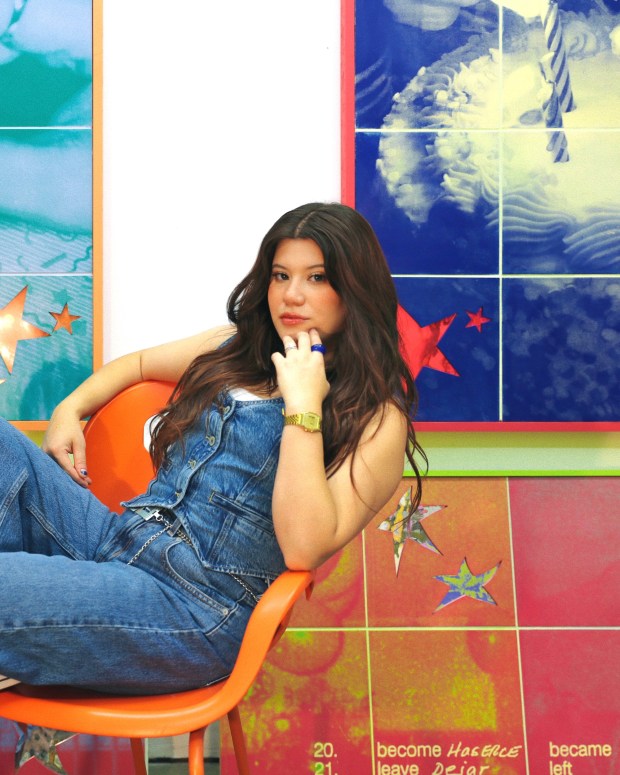
It wasn’t until her third year at UC Bakersfield that she changed her major to visual art. She particularly gravitated toward installation and sculptural work to “create an experience.” She began using text-based prompts to create unique art pieces that she’d tape up on the streets of Bakersfield and, on a family trip, on the calles of Guatemala.
“I’d hang them up in the street and just leave them there,” said Barahona, saying that the pieces resembled the birthday banners people hang at parties. “I would hang up all the letters, photograph them, and then move on to the next. That work is definitely in conversation with the work I’m doing now.”
One could easily see her current work as something in the vein of the Neo-conceptualists of the 1990s and the rise of text-based artists such as Barbara Kruger, Glenn Ligon and Jenny Holzer.
The concept of documentation also plays a part in her work. For example, in much of the work she produced at UCSD, Barahona said she became increasingly fascinated with the ever-changing ways in which past and current generations document their lives. What’s more, she wanted to explore the ways in which lives are still largely unknowable even in the current era of social media.
“Obviously it’s a different time than it was even 20 years ago, but I always see people talking about how, in the future, that because we’re taking a lot more videos and pictures, that our grandchildren are going to know who we are. But the reality is that they still probably won’t,” Barahona said. “That is something that interests me.”
She will explore these themes further at her current artist residency at the California Center for the Arts, Escondido Museum. She was handpicked for the recently revived summer residency program and there is a planned exhibition scheduled for August.
Along with six other local artists, Barahona was also recently named one of the Institute of Contemporary Art San Diego’s NextGen artists for 2024, with a group exhibition of work opening July 13 at the ICA Central location in Balboa Park.
“I am excited. I went by ICA last week to see where we’d be putting our stuff,” Barahona said when asked about the NextGen distinction and exhibition.
She also has another group exhibition with her UCSD cohort in Los Angeles planned for the summer. Once those are done, however, she said she’s looking forward to continuing to explore the cultural themes that have seemingly made her one of the most promising young artists in the city.
“I think wanting to do this type of work was always there, even when I was a kid,” Barahona said. “It comes in waves. I’ll be super into it and then I’ll get away from it for a while, but I’ll come back to it. It feels good right now.”
Deanna Barahona
Age: 26
Born: Los Angeles, California
Fun fact: In addition to her local showings, Barahona will also be participating in a summer exhibition at Museo Raúl Anguiano in Guadalajara, Mexico, and will have her first solo exhibition at the San Luis Obispo Museum of Art in 2025.
NextGen 2024
Exhibit will feature the work of seven emerging next generation artists in San Diego and Baja California: Deanna Barahona, Santiago Diaz, Celeste Hernández, JAX, Marinta Skupin, Chanell Stone and Nathan Storey
When: July 13 through Sept. 1
Where: ICA Central, 1439 El Prado, Balboa Park, San Diego
Admission: Free
Phone: (619) 236-0011
Online: icasandiego.org/netgen2024/

